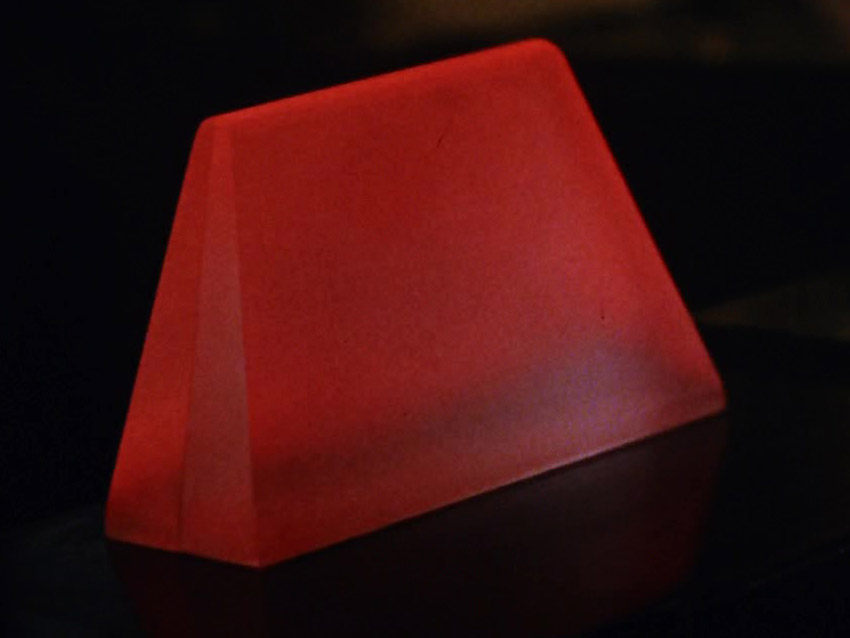Difference between revisions of "distress signal"
m |
m |
||
| Line 1: | Line 1: | ||
{{ImageInfoBox2|name=distress signal|file=alert_red-tos02.jpg|caption=Alert klaxon ([[Star Trek|TOS]] [[The Corbomite Maneuver (Episode)|02]])}} | {{ImageInfoBox2|name=distress signal|file=alert_red-tos02.jpg|caption=Alert klaxon ([[Star Trek|TOS]] [[The Corbomite Maneuver (Episode)|02]])}} | ||
| − | {{TableRow|title=Advertising|data={{AmazonLink2}} | + | {{TableRow|title=Advertising|data= |
| + | {{AmazonLink2}} | ||
{{AmazonLink2|asin=B00CM0XA1C}} | {{AmazonLink2|asin=B00CM0XA1C}} | ||
{{AmazonLink2|asin=B01BP06ENA}} | {{AmazonLink2|asin=B01BP06ENA}} | ||
| Line 11: | Line 12: | ||
}} | }} | ||
|}</div> | |}</div> | ||
| − | Old-style distress signals—such as those in use aboard the [[S.S. Columbia|S.S. ''Columbia'']] when it disappeared in [[Prime Chronology: 2236|2236]]—were designed to interfere with systems and attract the attention of a ship's crew. When the [[U.S.S. Enterprise NCC-1701|U.S.S. ''Enterprise'' NCC-1701]] intercepted an old-style signal in [[Prime Chronology: 2254|2254]], collision warnings and the [[red alert]] klaxon were activated in response.<ref name="TOS00"/> | + | Old-style distress signals—such as those in use aboard the [[S.S. Columbia|S.S. ''Columbia'']] when it disappeared in [[Prime Chronology: 2236|2236]]—were designed to interfere with systems and attract the attention of a ship's crew. When the [[U.S.S. Enterprise NCC-1701|U.S.S. ''Enterprise'' NCC-1701]] intercepted an old-style signal in [[Prime Chronology: 2254|2254]], collision warnings and the [[red alert]] klaxon were activated in response.<ref name="TOS00"/> When the ''Enterprise'' was confronted by the [[First Federation]] Starship ''[[Fesarius]]'' during a tense [[First Contact]] on [[Stardate]] [[Prime Chronology: 2266#SD1512|1514.1]], a small pilot vessel from the larger ship was disabled and sent out a weak distress signal.<ref name="TOS02"/> When [[Mudd, Harry|Harry Mudd]] fled into an [[asteroid field]] to escape pursuit by the ''Enterprise'' on Stardate [[Prime Chronology: 2266#SD1329|1329.1]], he sent out a distress signal when his ship's power began to fail and was in danger of being destroyed.<ref name="TOS03"/> |
{{References}} | {{References}} | ||
<references> | <references> | ||
<ref name="TOS00">{{RefTOS00}}</ref> | <ref name="TOS00">{{RefTOS00}}</ref> | ||
| + | <ref name="TOS02">{{RefTOS02}}</ref> | ||
| + | <ref name="TOS03">{{RefTOS03}}</ref> | ||
</references> | </references> | ||
[[Category:Library]] | [[Category:Library]] | ||
[[Category:Science & Technology]] | [[Category:Science & Technology]] | ||
| + | [[Category:Technology]] | ||
[[Category:TOS]] | [[Category:TOS]] | ||
[[Category:Film]] | [[Category:Film]] | ||
[[Category:Prime Timeline]] | [[Category:Prime Timeline]] | ||
Revision as of 21:26, 16 October 2020
| Advertising |
Old-style distress signals—such as those in use aboard the S.S. Columbia when it disappeared in 2236—were designed to interfere with systems and attract the attention of a ship's crew. When the U.S.S. Enterprise NCC-1701 intercepted an old-style signal in 2254, collision warnings and the red alert klaxon were activated in response.[1] When the Enterprise was confronted by the First Federation Starship Fesarius during a tense First Contact on Stardate 1514.1, a small pilot vessel from the larger ship was disabled and sent out a weak distress signal.[2] When Harry Mudd fled into an asteroid field to escape pursuit by the Enterprise on Stardate 1329.1, he sent out a distress signal when his ship's power began to fail and was in danger of being destroyed.[3]
Notes and References
- ↑ Template:RefTOS00
- ↑ Roddenberry, Gene (Executive Producer). "Where No Man Has Gone Before". Star Trek, season 1, episode 3 (Production number 02). Directed by James Goldstone. Written by Samuel A. Peeples. Desilu Productions. 22 September 1966.
- ↑ Roddenberry, Gene (Executive Producer). "The Corbomite Maneuver". Star Trek, season 1, episode 10 (Production number 03). Directed by Joseph Sargent. Written by Jerry Sohl. Desilu Productions. 10 November 1966.









